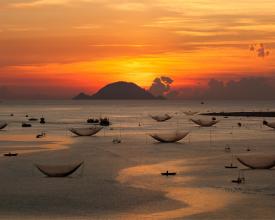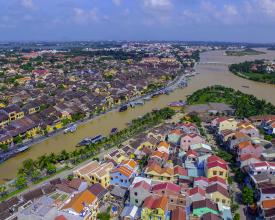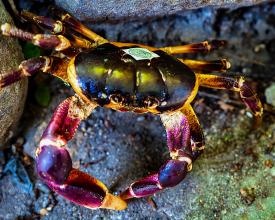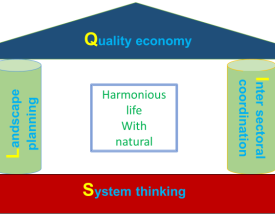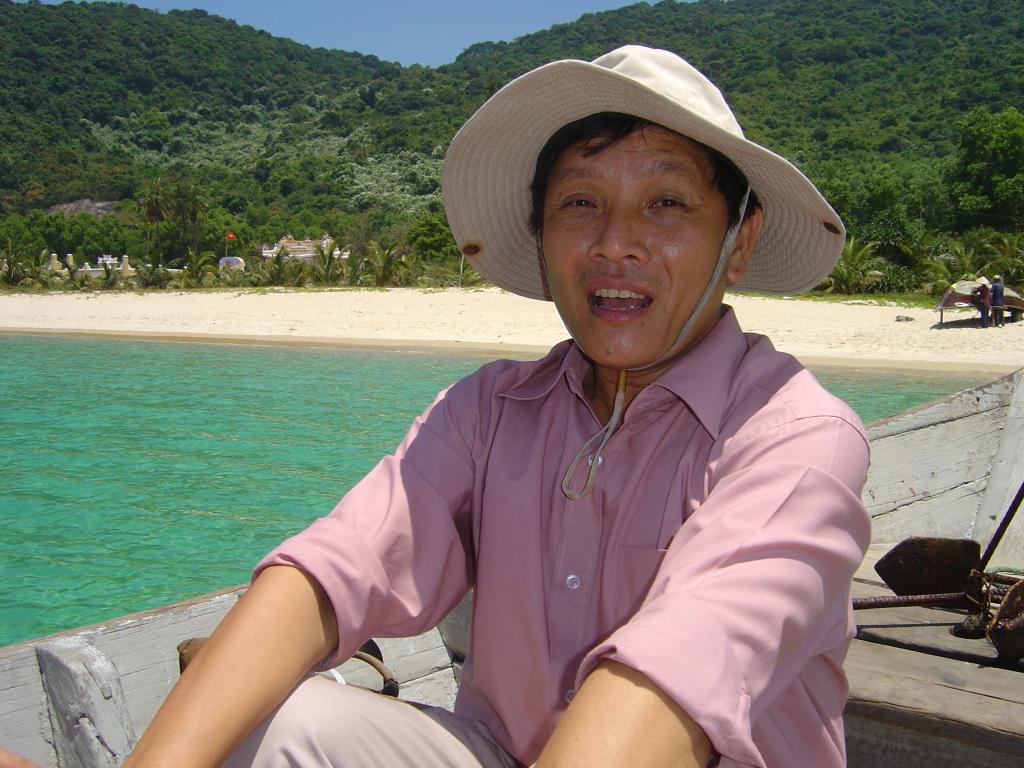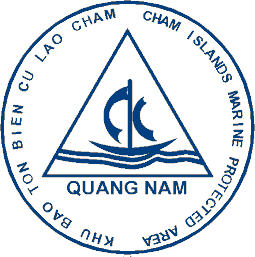
Aplicación del enfoque SLIQ para la gestión integrada de la Naturaleza y la Cultura en la Reserva de Biosfera de Cù Lao Chàm-Hôi An, Vietnam

Cù Lao Chàm-Hôi An (RBC) fue designada Reserva de la Biosfera por la UNESCO en 2009, con el Área Marina Protegida del archipiélago de Cù Lao Chàm como zona núcleo y la Ciudad Antigua de Hôi An, inscrita como Patrimonio de la Humanidad según los criterios (ii) y (v) en 1999, como zona de transición. La ribera, los humedales naturales, los manglares del estuario y las playas de la ciudad de Hôi An forman la zona tampón que conecta ambas áreas. El archipiélago es apreciado por sus especies marinas y las islas contienen zonas montañosas y ecosistemas de selva tropical. Hôi An, antiguo puerto comercial, es testigo de la fusión de las culturas vietnamita y europea. Para desarrollar una gestión integrada, MAB (El Hombre y la Biosfera) Vietnam ha diseñado el "Pensamiento sistémico - Planificación del territorio/paisaje marino - Coordinación intersectorial con participación de las partes interesadas - Modelo de economía de calidad" (modelo SLIQ) que permite a los responsables políticos, gestores, población local e investigadores colaborar y abordar problemas complejos de forma sistémica.
Contexto
Défis à relever
La Reserva de la Biosfera incluye zonas protegidas y zonas urbanas, que son interdependientes. Alinear los objetivos de protección del patrimonio cultural y natural teniendo en cuenta el desarrollo sostenible y los beneficios para la población local es el principal reto. El ecosistema marino del archipiélago de Cù Lao Cham es muy sensible al cambio climático. Los sedimentos y la contaminación procedentes del continente siguiendo la cuenca del río Thu Bon están atacando los arrecifes de coral y los lechos de hierbas marinas en las proximidades de las islas. Las islas y el estuario se enfrentan a peligros derivados de las actividades socioeconómicas a lo largo de las cuencas fluviales y las playas de la costa. Los tifones y las inundaciones que provocan afectan directamente a la antigua ciudad de Hôi An. Los barcos de pesca, las lanchas rápidas para turistas y el movimiento de embarcaciones ponen en peligro los hábitats marinos y los ecosistemas acuáticos de la zona marina protegida. El desarrollo de infraestructuras a lo largo de los ríos, en las dunas de arena y en las playas está modificando la morfología, lo que repercute en los hábitats y los ciclos de vida.
Ubicación
Procesar
Resumen del proceso
Abordar la interdependencia de los sistemas naturales y culturales es un requisito para diseñar y gestionar una reserva de la biosfera (BB2). En el caso de la RBC, las designaciones de Patrimonio Mundial y Patrimonio Cultural Inmaterial permitieron una sólida colaboración entre los organismos nacionales y locales de conservación del patrimonio cultural y la naturaleza. Al utilizar el esquema de designación múltiple, el consejo de gestión de la RBC se coordina con diferentes niveles y diferentes instrumentos jurídicos para conservar la RBC en su conjunto (BB1). El modelo SLIQ se aplica en el diseño y la gestión de la RBC teniendo en cuenta la zonificación (BB3), el sistema de gobernanza y la gestión intersectorial (BB4), e incluyendo la preocupación por los beneficios que las comunidades locales necesitan recibir de estas designaciones internacionales, generando medios de vida sostenibles (BB5).
Bloques de construcción
Organismo coordinador de múltiples designaciones internacionales y nacionales
El Consejo de Administración de la RBC coordina todas las actividades relacionadas con los valores culturales y naturales de la Reserva de la Biosfera. En el procedimiento de desarrollo, la RBC intenta crear un lugar seguro para que las partes interesadas trabajen juntas y encuentren soluciones integradas. Una de las principales tareas del Consejo de Administración de la RBC es coordinar las diferentes designaciones internacionales y nacionales que incluyen la Reserva de la Biosfera, el sitio del Patrimonio Mundial, el patrimonio cultural inmaterial y el área marina protegida. El plan maestro y el programa de aplicación de la RBC están siempre en proceso de elaboración, actualización y coordinación con las partes interesadas, incluidas las cuatro entidades principales: gobierno, científicos, sector privado y población local. La mayoría de los dirigentes de la ciudad fueron invitados a formar parte del consejo de administración de la RBC. Esta es una característica importante del sistema que sirve para facilitar la recopilación de información y datos, debatir y reflexionar en talleres y reuniones, analizar problemas y encontrar soluciones al respecto. Todos los coordinadores de la RBC responden al equilibrio entre conservación y desarrollo, centrándose en el desarrollo sostenible y la resistencia al cambio climático.
Factores facilitadores
- La RBC ha creado una buena relación con las comunidades locales y las partes interesadas que colaboran en la conservación, el desarrollo de los medios de subsistencia, el ecoturismo y la educación, convirtiéndose en un espacio para el pensamiento sistémico, la reflexión sobre los vínculos con la naturaleza y la armonización entre los seres humanos y la biosfera.
- La existencia de múltiples designaciones, como la de Patrimonio de la Humanidad, la de Área Marina Protegida (AMP) y la de Patrimonio Cultural Inmaterial, llaman la atención de lugareños, autoridades y turistas.
Lección aprendida
Con tantas designaciones diferentes a distintos niveles, hay varios enfoques que deben integrarse y coordinarse en los planes de acción, como el enfoque ecosistémico, el enfoque de cuencas hidrográficas, la gestión costera integrada y el enfoque de cresta a arrecife (2R) para desarrollar modelos de gestión. Por ejemplo, la provincia de Quang Nam ha asignado 19 de las 235 hectáreas del área marina protegida de Cù Lao Chàm a los pescadores locales de la aldea de Bai Huong para que gestionen los recursos marinos y desarrollen el ecoturismo basándose en los resultados de la conservación desde 2013. Se trata de un proceso de toma de decisiones compartido que incluye al Gobierno, las comunidades locales y otras partes interesadas. Los pescadores locales crearon por sí mismos los planes de gestión de los recursos. Con este pensamiento sistémico, los socios locales serán los verdaderos propietarios de los recursos naturales y culturales. Son ellos quienes toman las decisiones en el mantenimiento de los valores de la Reserva de la Biosfera para las generaciones futuras.
Comprender las diferentes escalas de interacción entre los sistemas naturales y culturales utilizando el enfoque del pensamiento sistémico.
El pensamiento sistémico es un enfoque científico que parte del todo. Se utiliza para diseñar reservas de biosfera individuales, pero también para conectarlas con toda la red internacional. Tiene en cuenta tanto las relaciones complejas como las variables "blandas" que sustentan las emociones, la motivación y el comportamiento humanos, proporcionando así un enfoque holístico de las complejas cuestiones políticas y sociales. Desde esta perspectiva, las reservas de la biosfera constan de varios componentes que reflejan relaciones complejas entre factores naturales y socioeconómicos, entre estructuras físicas y valores humanos, entre espacio cultural y paisaje natural, ecología política y ecología creativa. La aplicación del pensamiento sistémico se lleva a cabo desde la fase de preparación de la candidatura de una reserva de la biosfera hasta el diseño, la planificación de la gestión y la puesta en marcha. Aplicar el pensamiento sistémico al diseño de una reserva de la biosfera permite identificar todos los elementos del ecosistema más amplio. En el caso de la RBC, este enfoque permite conectar la ciudad antigua, influyente en el desarrollo de todo el ecosistema, como puerto histórico y su patrimonio cultural en relación con la zona marina protegida.
Factores facilitadores
En CBR, la interconexión ecológica entre la ciudad patrimonial y la zona protegida era evidente y el diseño debía tener en cuenta la interfaz del estuario entre los sistemas culturales (asentamientos) a lo largo del río Thu Bon, los manglares y el mar.
Lección aprendida
(1) El pensamiento sistémico es una herramienta para que gestores y responsables políticos esbocen soluciones adecuadas a problemas prácticos.
(2) El pensamiento sistémico diferencia los problemas fundamentales de sus síntomas y facilita tanto las intervenciones a corto plazo como las estrategias sostenibles a largo plazo.
Zonificación basada en el modelo patch-corridor-matrix (ordenación del paisaje)
Para establecer una zonificación funcional, es vital la conexión entre los distintos componentes del uso del suelo. La planificación del paisaje es una herramienta de integración y crea unas condiciones viables para aplicar una gestión basada en el pensamiento sistémico. El uso del modelo de la matriz parche-corredor de la ecología del paisaje permite la conectividad de los hábitats y la conservación de la biodiversidad.
La zonificación de la RBC identifica claramente que la zona núcleo es la AMP, encargada de proteger los bosques primarios de las islas y el paisaje marino. La zona de transición es el casco antiguo, y estos dos centros de conservación se conectan a través de la zona tampón de ríos, manglares, estuario y mar. Cada zona tendrá su propio plan de desarrollo basado en la zonificación principal del CBR. Concretamente, en la zona núcleo, el gobierno no permite la construcción de grandes hoteles, dando prioridad al desarrollo de casas de familia; las construcciones están restringidas en altura, materiales y procedimientos operativos para garantizar que no perturben el paisaje ecológico forestal y marino. En la zona de transición, el casco antiguo se preserva mediante normas de construcción. Todas las actividades socioeconómicas que tienen lugar en la zona de amortiguación se planifican basándose en la protección y promoción de los valores de los ecosistemas fluviales, de manglares y de playa.
Factores facilitadores
Un año después de recibir la designación de RBC por la UNESCO, la ciudad de Hoi An estableció rápidamente cinco subzonas de desarrollo económico (2010) y luego las ajustó en tres subzonas correspondientes a las tres zonificaciones funcionales de la RBC. Esto confirma la estrategia de desarrollo de la ciudad basada en el valor excepcional de cada área que la RBC ha asignado en la zonificación y los vínculos entre los recursos naturales y culturales en toda la RBC.
Lección aprendida
(1) Necesidad de principios para aplicar modelos de ecología paisajística que puedan ser predictivos.
(2) Tras muchas recomendaciones, la ciudad ha aceptado invitar a los miembros del consejo de administración de la RBC a participar en la mayoría de las aprobaciones del consejo para ideas de planificación, construcción de infraestructuras, inversión en proyectos y todos los servicios en toda la ciudad. Los miembros de la RBC han utilizado el principio SLIQ, basado en el paisaje terrestre y marino y en los valores excepcionales de cada zona de la RBC, para reflexionar y comentar todas las propuestas de proyectos. Esta consulta de la RBC ha ayudado a la ciudad a alcanzar sus objetivos de desarrollo sostenible y a cumplir los 7 criterios de la RBC de la UNESCO.
(3) El modelo SLIQ también se utiliza para crear modelos de medios de vida sostenibles basados en la cadena de valor de los recursos naturales y en el reparto de beneficios entre las numerosas partes interesadas.
(4) Además, también se invita a los miembros de la RBC a participar en los consejos de Evaluación Estratégica y Ambiental (EAE) y de Evaluación del Impacto Ambiental (EIA) de la mayoría de los proyectos de inversión.
Asociación entre el Estado, el mercado y la sociedad civil (coordinación intersectorial)
La gestión de la RBC consiste en la coordinación y utilización de los instrumentos disponibles a nivel local, los recursos humanos y los recursos financieros. Requiere considerar los beneficios y responsabilidades compartidos en la gestión de los recursos naturales de la agricultura, la silvicultura, la pesca y la ciencia, implicando a las autoridades locales y nacionales y a la comunidad internacional. La coordinación intersectorial consiste en reunir a los actores del Estado y de la sociedad civil para lograr un entendimiento mutuo sobre un problema y negociar y aplicar planes de mutuo acuerdo para abordar el problema una vez identificado. Para ello, pueden combinarse enfoques descendentes y ascendentes. El consejo de gestión está compuesto por los departamentos provinciales de agricultura y desarrollo rural, recursos naturales y medio ambiente, cultura y turismo, y ciencia y tecnología. Estos departamentos siguen las directrices del Gobierno central, especialmente las normativas aplicadas a las zonas núcleo, es decir, un enfoque descendente. Además, hay asociaciones de agricultores, mujeres, jóvenes, empresas y el sector privado que participan en el consejo de administración y en el proceso de toma de decisiones, es decir, un enfoque ascendente. El líder es la autoridad provincial presidida por el vicepresidente del Comité Popular.
Factores facilitadores
Designación internacional como Reserva de la Biosfera.
Lección aprendida
A la hora de abordar los problemas de desarrollo, la coordinación intersectorial es una estrategia que optimiza los puntos fuertes respectivos de los distintos sectores al tiempo que limita el impacto de sus debilidades individuales.
Uso de la marca Reserva de la Biosfera (Economía de calidad)
La economía de calidad se basa en el éxito de la conservación o en la economía basada en la conservación establecida en las directrices del MAB de Vietnam en 2009. El etiquetado y la marca de los bienes y servicios de la RBC podrían ayudar a promover el desarrollo de economías de calidad en la RBC y su desarrollo sostenible. En el contexto del desarrollo económico de la RBC, la calidad incluye la creación de valor y el aumento de los beneficios económicos para el consumo de la población local; la producción en consonancia con el desarrollo sostenible; la distribución justa, la solidaridad; la concienciación sobre la conservación de la naturaleza y la cultura y la creación de redes entre las reservas de biosfera. El éxito de la conservación crea un valor de prestigio. El etiquetado bajo este concepto aporta un valor añadido a los productos locales creando una contribución y un reconocimiento a las comunidades locales y a sus esfuerzos en la conservación.
Factores facilitadores
Designación internacional como Reserva de la Biosfera.
Lección aprendida
(1) El sector del mercado está formado por entidades privadas que se organizan en torno al incentivo del precio en la producción y el consumo de bienes y servicios. La calidad de los productos debe controlarse y registrarse.
(2) Los productos locales no suelen cumplir los criterios de calidad, por lo que la coordinación intersectorial y la economía de la calidad deberían unirse para poner en marcha la iniciativa con la participación de la comunidad implicada en el proceso.
Impactos
Abordar los valores sistémicos de la RBC es un reto, porque aunque la RBC posee recursos naturales y culturales muy ricos, sus vínculos son casi invisibles a los ojos comunes. El uso del enfoque SLIQ no sólo muestra los valores de la naturaleza y las culturas humanas, sino que también aclara sus destacadas interrelaciones. Algunos impactos de la aplicación del modelo SLIQ en la RBC son:
- Mayor concienciación de las partes interesadas (incluidos el gobierno, los científicos, el sector privado y las comunidades locales) y cambio en su comportamiento, que ahora se centra en la protección de los vínculos entre los recursos naturales y culturales.
- SLIQ apoya la coordinación eficaz de las actividades de RBC, equilibrando el desarrollo y la conservación.
- Utilización del enfoque SLIQ para dirigir todas las inversiones en RBC hacia un desarrollo sostenible.
- Proyectos basados en la aplicación del modelo SLIQ, como el "Establecimiento del modelo piloto de Refugio Pesquero en dos hábitats diferentes (arrecife de coral y bosque de manglar) en la Reserva de la Biosfera de Cù Lao Chàm-Hôi An" y la "Conservación basada en la comunidad y recolección sostenible del cangrejo de tierra de Cù Lao Chàm, Quang Nam".
Beneficiarios
Todas las partes interesadas, órganos de gobierno y comunidades locales
Objetivos de Desarrollo Sostenible
Historia
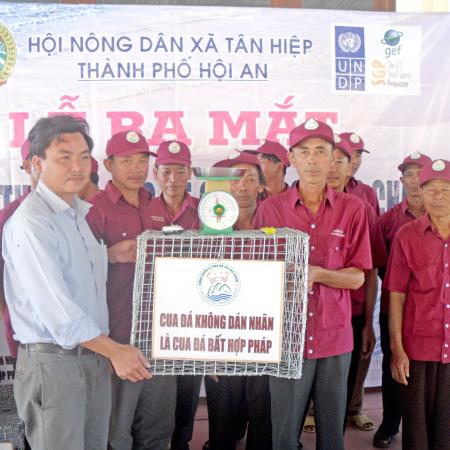
Los cangrejos terrestres, Gecarcoidea lalandii, nativos de bosques y zonas de mareas, se consideran un factor trópico que sostiene la cadena alimentaria y la red trófica en el ecosistema marino-montañoso de las islas Cham, zona núcleo de la RBC. La población de cangrejos terrestres se utiliza como indicador de la salud y los vínculos de los ecosistemas forestales y marinos.
Desde 2009, el número de turistas ha aumentado rápidamente, lo que ha incrementado la demanda de cangrejo terrestre. El cangrejo terrestre se ha visto sometido a una gran presión por la disminución de su población, y el tamaño de los cangrejos capturados es cada vez menor. La ciudad de Hoi An prohibió rápidamente las actividades de explotación y consumo de cangrejos terrestres en las islas Cham a partir de 2009. Desde entonces, pienso en aplicar el modelo SLIQ en todas las tomas de decisiones. Me ayudó a comprender que los recursos de la RBC deben preservarse, pero también deben explotarse adecuadamente para el sustento local.
A partir de ese pensamiento, se ha aplicado una serie de criterios para la explotación del cangrejo terrestre que incluyen: Restricciones de tiempo de captura, venta y uso; cuota de captura de cangrejo de tierra; restricciones de tamaño de captura de cangrejo de tierra; prohibición de capturar cangrejos hembra portadores de huevos; precio fijo; y ecoetiquetado. Los resultados de este modelo se basan en el modelo SLIQ de la siguiente manera:
- Pensamiento sistémico: La explotación del cangrejo terrestre no es sólo para la venta, sino que está relacionada con muchas cuestiones, como la ecología, el medio ambiente, el mercado, la comunidad y las partes interesadas, la aplicación de la ley, los convenios internacionales y otras.
- Planificación del paisaje: La explotación y el consumo del cangrejo terrestre en las islas están controlados por el equipo local de aplicación de la coalición siguiendo los criterios. Este proceso controla los impactos sobre el medio ambiente y apoya la planificación del paisaje y la estrategia de desarrollo sostenible de la Ciudad Antigua de Hoi An.
- Coordinación intersectorial: Este modelo sólo puede funcionar con la participación de las cuatro fuerzas Gobierno - Científicos - Sector privado - y Comunidad local. Cada fuerza tendrá su propio papel, tareas y beneficios, pero todos hacia el objetivo común de equilibrio entre la conservación y la explotación sostenible del cangrejo terrestre en la RBC.
- Economía de calidad: Antes de aplicar el modelo, el cangrejo de roca se explotaba en cualquier tamaño y en cualquier momento. Las poblaciones de cangrejos en libertad están en peligro de extinción, pero los ingresos de la población siguen siendo bajos debido al precio (2 USD por 1 kilogramo). El precio subió a 20 USD al iniciarse el modelo y alcanzó los 40 USD en la actualidad. Este modelo ha demostrado que el desarrollo de los medios de subsistencia basado en la conservación de los recursos aumenta el valor del producto. (Thao Le Ngoc, Jefe de la Secretaría)

